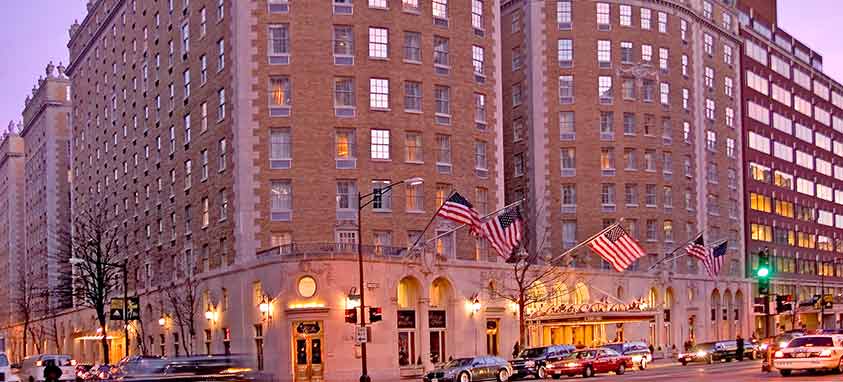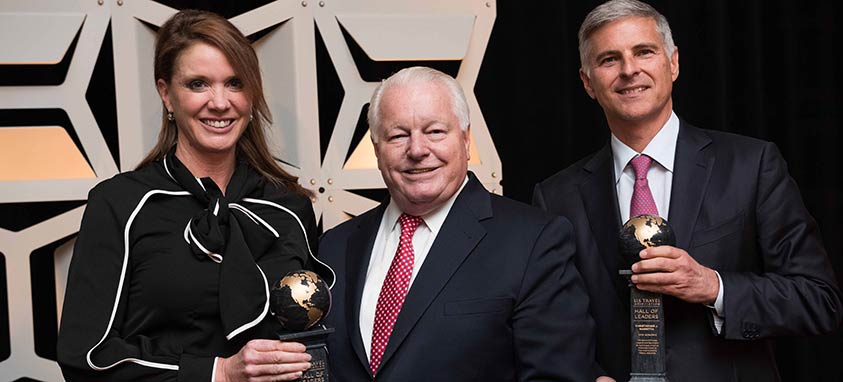 Mayflower Hotel, Washington, DC
Mayflower Hotel, Washington, DC
Back on Oct. 16, 1941, travel industry visionaries gathered at Mayflower Hotel in Washington, DC, to organize a movement that is celebrating its 75th birthday this week during the annual fall board meeting for U.S. Travel Association.
Just as U.S. Travel stood up for the benefits of the mega industry during the most recent recession, the organization began as National Association of Travel Officials (NATO) to serve as an advocacy arm when most of the world was experiencing travel anxiety due to World War II. Advocacy for the travel industry was its prime motivation 75 years ago and it’s still a driving force today.
“This celebration is a look back at the remarkable work we have done to protect and promote travel—and a reminder of all we must continue to do to keep travelers moving to and within our country,” “night we will mark more than an anniversary of our industry’s voice in Washington,” says Roger Dow, president and CEO of U.S. Travel Association. “Our association was founded in the face of adversity, and we have weathered many storms in our 75 years of existence, but we have survived and thrived in even the most challenging of circumstances.”
Dow says U.S. Travel is committed to working with the Trump administration and the new Congress on policies that will keep travelers moving, and keep the United States an attractive and welcoming destination.
In addition to the 75th birthday party, the fall board meeting featured a ceremony for the next class of the U.S. Travel Hall of Leaders. New inductees are Caroline Beteta, president and CEO of Visit California, and Chris Nassetta, president and CEO of Hilton Worldwide and incumbent chairman of U.S. Travel’s CEO Roundtable.
U.S. Travel Association
Milestones from 1941 to 2016
Oct. 16, 1941: Industry visionaries forge national association to represent travel industry’s total scope in a meeting at the Mayflower Hotel in Washington, DC. It is called the National Association of Travel Officials (NATO).
1945: “Victory Vacation Year” promoted by nascent travel industry to restore domestic vacation travel following World War II. It is the first industry-wide domestic travel promotion.
1950: NATO headquarter office established in Washington, DC and its first paid staff is hired.
1951: Organization’s name revised to National Association of Travel Organizations.
1958: Proclamation by President Dwight D. Eisenhower declares 1960 the “Visit the U.S.A.” year, encouraging foreign nationals (and Americans) to visit the United States.
1961: International Travel Act passed by Congress and signed by President John F. Kennedy, creating United States Travel Service (now the National Travel and Tourism Office), a new agency within the U.S. Department of Commerce.
1963: Association responds to President Kennedy’s call to “See the U.S.A.” by establishing a broad industry campaign.
1965: Discover America, Inc. forms to develop a private-sector marketing program after Congress and President Lyndon B. Johnson urge Americans to see America.
1967: President Johnson appoints a Cabinet Task Force on Travel.
1969: NATO and Discover America merge, becoming Discover America Travel Organizations (DATO).
1969: First “Discover America International Pow Wow” (now IPW) held at Commodore Hotel in New York City.
1969: Association establishes a National Council of State Travel (now Tourism) Directors (NCSTD).
1972: U.S. Travel Data Center created to develop credible research data on the U.S. travel industry. (The Data Center merges into U.S. Travel in 1995.)
1976: Association establishes a National Council of Area and Regional Travel Organizations; the National Council of Urban Tourism Organizations; and the National Council of Travel Attractions.
1979/1980: U.S. Senate and House of Representatives establish tourism caucuses
1980: Organization’s name is changed to Travel Industry Association of America (TIA).
1981: National Tourism Policy Act passed by Congress and signed by President Ronald Reagan.
1982: Association establishes a Travel and Tourism Government Affairs Council.
1984: President Ronald Reagan signs proclamation establishing “National Tourism Week.”
1984: First ESTO conference held, in Lawrence, Kansas.
1985: Association establishes USA Marketing Council following work by a committee that created a marketing plan for the federal government to increase America’s share of international visitors.
1986: Association’s National Tourism Awareness Council established.
1995: President William J. Clinton holds first-ever White House Conference on Travel and Tourism, attended by 1,700 industry leaders from all U.S. states and territories.
2000: Association opens offices in London, Tokyo and Sao Paulo and launches SeeAmerica brand and SeeAmerica campaign as elements of a strategic plan to promote increased travel to U.S. from Europe, Asia, Latin America.
2002: President George W. Bush lends support to restoring travel following September 11th by appearing in public service television campaign airing in the U.S. and abroad.
2006: Industry business leaders form the Discover America Partnership to facilitate increased travel to U.S. from overseas by improving visa and entry system, creating a global marketing program.
2006: First Travel Leadership Summit (now Destination Capitol Hill) held to convene travel industry advocates with lawmakers.
2009: The U.S. Travel Association is formed when the Travel Business Roundtable, TIA and Discover America Partnership become a single organization to best represent the domestic and international issues affecting the U.S. travel community.
2009: U.S. Travel leads corporate travel executives to White House for a meeting with President Barack Obama.
2010: President Obama signs the bipartisan Travel Promotion Act, creating Brand USA.
2012: White House releases National Travel and Tourism Strategy, setting a goal of drawing 100 million international visitors by 2021.
2013: Association launches Project: Time Off to promote the value of time and win back America’s Lost Week.
2014: President Obama meets with travel executives at White House and signs a Presidential Memorandum to help welcome more international visitors to the U.S.
2014: Congress reauthorizes Brand USA through 2020.
2015: Congress passes FAST Act, a long-term surface transportation package with U.S. Travel-backed provisions that ensure travel leader engagement in critical transportation planning.
2015: Association defends and protects U.S. Visa Waiver Program from policies that would undermine its security measures and hinder international travel to U.S. Legislation enacted to strengthen and enhance the program.
Nov. 16, 2016: U.S. Travel salutes its 75th anniversary at Hall of Leaders Dinner in Washington, DC.




